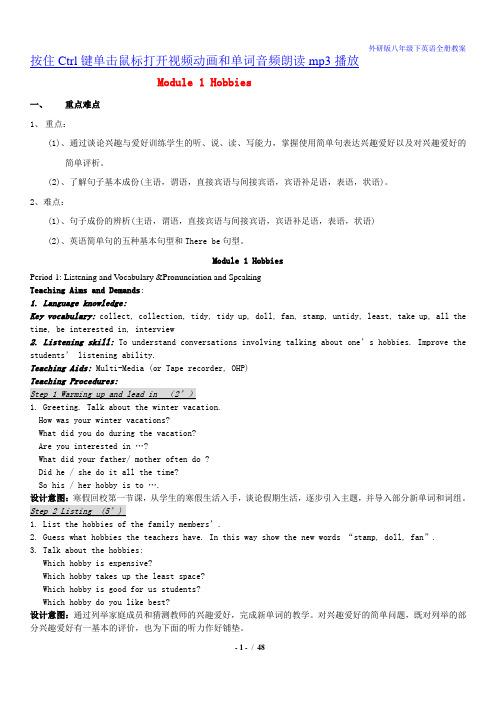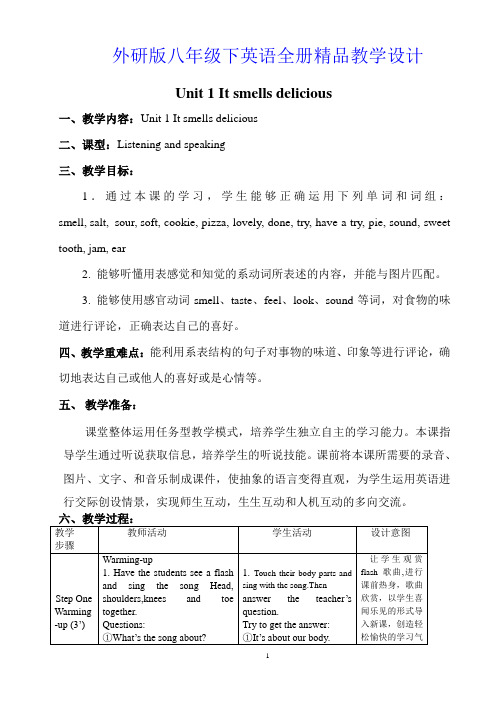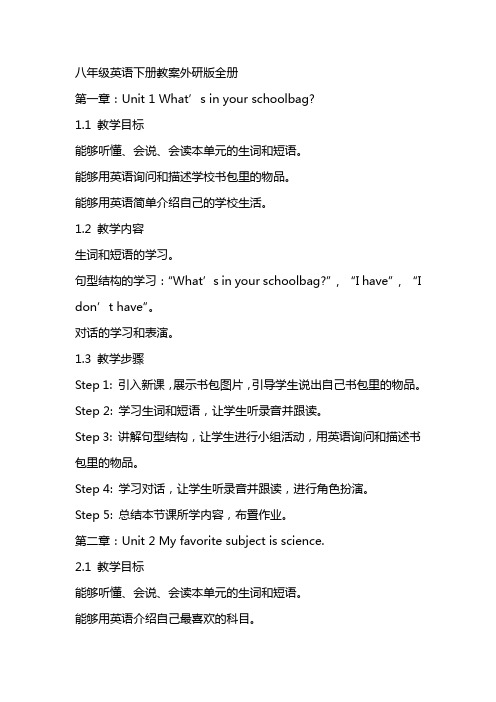2020春外研版八年级英语下册全册教学设计(付,67)
- 格式:doc
- 大小:704.50 KB
- 文档页数:67

按住Ctrl键单击鼠标打开视频动画和单词音频朗读mp3播放Module 1 Hobbies一、重点难点1、重点:(1)、通过谈论兴趣与爱好训练学生的听、说、读、写能力,掌握使用简单句表达兴趣爱好以及对兴趣爱好的简单评析。
(2)、了解句子基本成份(主语,谓语,直接宾语与间接宾语,宾语补足语,表语,状语)。
2、难点:(1)、句子成份的辨析(主语,谓语,直接宾语与间接宾语,宾语补足语,表语,状语)(2)、英语简单句的五种基本句型和There be句型。
Module 1 HobbiesPeriod 1: Listening and Vocabulary &Pronunciation and SpeakingTeaching Aims and Demands:1. Language knowledge:Key vocabulary: collect, collection, tidy, tidy up, doll, fan, stamp, untidy, least, take up, all the time, be interested in, interview2. Listening skill: To understand conversations involving talking about one’s hobbies. Improve the students’ listening ability.Teaching Aids: Multi-Media (or Tape recorder, OHP)Teaching Procedures:1. Greeting. Talk about the winter vacation.How was your winter vacations?What did you do during the vacation?Are you interested in …?What did your father/ mother often do ?Did he / she do it all the time?So his / her hobby is to ….设计意图:寒假回校第一节课,从学生的寒假生活入手,谈论假期生活,逐步引入主题,并导入部分新单词和词组。

外研版八年级下英语全册精品教学设计Unit 1 It smells delicious一、教学内容:Unit 1 It smells delicious二、课型:Listening and speaking三、教学目标:1.通过本课的学习,学生能够正确运用下列单词和词组:smell, salt, sour, soft, cookie, pizza, lovely, done, try, have a try, pie, sound, sweet tooth, jam, ear2. 能够听懂用表感觉和知觉的系动词所表述的内容,并能与图片匹配。
3. 能够使用感官动词smell、taste、feel、look、sound等词,对食物的味道进行评论,正确表达自己的喜好。
四、教学重难点:能利用系表结构的句子对事物的味道、印象等进行评论,确切地表达自己或他人的喜好或是心情等。
五、教学准备:课堂整体运用任务型教学模式,培养学生独立自主的学习能力。
本课指导学生通过听说获取信息,培养学生的听说技能。
课前将本课所需要的录音、图片、文字、和音乐制成课件,使抽象的语言变得直观,为学生运用英语进行交际创设情景,实现师生互动,生生互动和人机互动的多向交流。
达标训练题一. 根据句意和汉语提示完成句子。
1. 这菜闻起来好香啊.The dish _______________.2. 这汤尝起来不新鲜.The soup ______________ fresh.3. 这毛衣摸起来很软很舒服。
The sweater _______________________.4. Children like _______ (小甜饼)very much.5. People should eat less ______ ( 盐) everyday.6. Oh. It’s my _______(幸运的)day. I'vepassed the exam.二. 单项选择:1. These flowers ______beautiful. I will buy some for my mother.A. lookB. soundC. hearD. taste2. The air in the countryside smells _______.A. sourB. softC. deliciousD. fresh3. The idea ________ g ood. We can try it.A. tasteB. tastesC. soundsD. sound4. This game is so interesting, please_____ .A. have a lookB. give upC. have a tryD. try some5. Last Sunday was my mother’s birthday, so I _____ a big meal for her.A. cookB. cooksC. cookedD. is cookingBook 4 Module 1 Feelings and impressionsUnit 2 I feel nervous when I speak Chinese.一、教学内容:Unit 2 I feel nervous when I speak Chinese.二、课型:Reading and writing三、教学目标:1、通过本课的学习,学生能够朗正确运用下列单词和词组:fair, glasses, proud, be proud of, jeans, pretty, stranger, nervous, message, hobby, at school , mark, love, sb. can’t wait to do sth.2、进一步学习感官动词f eel look smell taste的用法,在理解的基础上,学会用它们表达情感3、能读懂对人外貌和性格的简单描述。

八年级英语下册教案外研版全册第一章:Unit 1 What’s in your schoolbag?1.1 教学目标能够听懂、会说、会读本单元的生词和短语。
能够用英语询问和描述学校书包里的物品。
能够用英语简单介绍自己的学校生活。
1.2 教学内容生词和短语的学习。
句型结构的学习:“What’s in your schoolbag?”, “I have”, “I don’t have”。
对话的学习和表演。
1.3 教学步骤Step 1: 引入新课,展示书包图片,引导学生说出自己书包里的物品。
Step 2: 学习生词和短语,让学生听录音并跟读。
Step 3: 讲解句型结构,让学生进行小组活动,用英语询问和描述书包里的物品。
Step 4: 学习对话,让学生听录音并跟读,进行角色扮演。
Step 5: 总结本节课所学内容,布置作业。
第二章:Unit 2 My favorite subject is science.2.1 教学目标能够听懂、会说、会读本单元的生词和短语。
能够用英语介绍自己最喜欢的科目。
能够用英语询问和描述别人的兴趣爱好。
2.2 教学内容生词和短语的学习。
句型结构的学习:“My favorite subject is”, “I like”, “I don’t like”。
对话的学习和表演。
2.3 教学步骤Step 1: 引入新课,展示学科图片,引导学生说出自己最喜欢的科目。
Step 2: 学习生词和短语,让学生听录音并跟读。
Step 3: 讲解句型结构,让学生进行小组活动,用英语介绍自己最喜欢的科目。
Step 4: 学习对话,让学生听录音并跟读,进行角色扮演。
Step 5: 总结本节课所学内容,布置作业。
第三章:Unit 3 Could you please clean your room?3.1 教学目标能够听懂、会说、会读本单元的生词和短语。
能够用英语提出请求和表达意见。
能够用英语描述日常生活中的事情。


Module 1 Feelings and impressions一、学习目标:A. 单词和短语:smell-smelled-smelled (smelt-smelt), soft, sour, mm, cookie, pizza, lovely, done, try, have a try, pie, sound, sweet tooth, salt, jam, for, favorite, ear, glasses, jeans, nervous, fair, pretty, proud, be proud of , stranger, message, sb. can’t wait, hobby, at school, in, mark, loveB. 交际用语:1. I’m afraid…2. Have a try!3. It’s my lucky day!4. It smells too strong and it tastes a bit sour.5. They taste really sweet and they feel soft in the middle.6. —Do you like bananas?—Yes, I do. They taste delicious. Do you like flowers?7. It tastes good.8. It doesn’t smell fresh.9. You look very pretty.10. I get bad marks at school, and I feel sad.11. I often feel a bit sad at first when I leave my mum and dad for a few days.12. I’m quite shy when I’m with stranger.13. I feel nervous when I speak Chinese.14. I’m always sorry when I don’t know how to do things in the right way.15. I’m afraid of flying.二. 教学目标1. Function: Describing feelings and impressions.2. Structure: Sense verbs: feel, look, sound, smell, taste, adjectives3. Skills:1) Listening for specific information; matching sentences with pictures.2) Talking about likes and dislike.3) Reading and understanding behavior of characters; finding specific information4) Writing a description of a classmate.4. Around the world: Polite expressions5. Task: Writing a description of a classmate.三、重点及难点:Sense verbs: feel, look, sound, smell, taste, adjectives四、教学设计:Unit 1 It smells delicious.ⅠTeaching modelListening and speakingⅡTeaching methodPWP approachⅢTeaching aims1. To listen and understand sentences with sense verbs.2. To understand the conversation.3. To learn to use sense verbs.ⅣTeaching Objectives1. Key vocabulary: smell-smelled-smelled (smelt-smelt), soft, sour, mm, cookie, pizza,lovely, done, try, have a try, pie, sound, sweet tooth, salt, jam, for,favorite, ear2. Key structures:Sense verbs: feel, look, sound, smell, taste, adjectivesⅤTeaching aidsTape recorder, OHP, videoⅥTeaching StepsStep 1 Warming-up1. Show some pictures to introduce the sense verbs.2. Show some pictures to introduce the new words.3. Learn the new words.Step 2 Listen and number the pictures.1. Ask the students to read the word and expressions in Activity 1.2. Ask the students to look at the pictures in Activity 1 carefully.3. Listen and number the pictures.4. Ask the students to check their answer with a partner.5. Call back the answer from the whole class and check the answer.Step 3 Listen again and complete the sentences.1. Ask the students to read the word and expressions in Activity2.1) The cookie tastes sweet.2) The milk _____________.3) This bed _____________.4) Tom ______________.2 Listen again and complete the sentences.3. Ask the students to check their answer with a partner.4. Call back the answer from the whole class and check the answer.Keys: 1. tastes sweet 2. smells sour 3. feel a bit soft 4. looks very strong Step 4 Listen and read.1. Show some pictures, and ask the students to talk about them.2. Ask the students to read the conversation silently.3. Play the recording and ask the students to listen and read the conversation.4. Read the conversation.5. Act it out.6. Learn “Everyday English”I’m afraid…Have a try!It’s my lucky day!7. Now check (√) what Betty is making in Activity 3.8. Ask the students to check their answer with a partner.9. Call back the answer from the whole class and check the answer.Step 5 Complete the sentences with the words in the box.1. Ask the students to read the words in the box in Activity 4.2. Ask the students to read through the sentences in Activity 4.1) I bought a large chocolate cake, because I love _____________ food.2) Dried fish has a _____________ taste. You don’t need much of it in the dish.3) She does not put ______________ in tea because she does not like sweet tea4) The milk has gone ______________ overnight, so we cannot drink it.5) The bed feels ________________ and comfortable.6) Apple pie sounds _____________. It is my favourite.3. Complete the sentences with the words in the box.4. Check with a partner.5. Call back the answers from the whole class.Keys: 1.sweet 2. strong 3. sugar 4. sour 5. soft 6. lovely6. Read the sentences together.Step 6 Complete the table in Activity 5.1. Ask the students to read the words in Activities1-4.2. Complete the table with the words in the boxes in Activities 1 and 4.3. Check with a partner.4. Call back the answers from the whole class.Step 7Pronunciation and speaking1. Play the recording once without stopping.2. Play the recording again and ask the whole class to repeat.1) It smells too strong and it tastes a bit sour.2) They taste really sweet and they feel soft in the middle.3. Ask the students to listen and underline the words the speaker stresses.4. Now listen again and repeat.Step 8 Work in pairs.1. Ask and answer about the things in the box.2. Say why you like or do not like them.—Do you like bananas?—Yes, I do. They taste delicious. Do you like flowers?Step 9 Grammar感官系动词:英语动词中,有的后面要接名词或代词等作宾语,有的单独作谓语,而有的后面要接形容词或名词等做主语的补充成分。

Unit 1 It smells delicious一、教学内容:本单元的对话主要以表感觉和知觉的系动词的用法为主,表达对食物或事物的感觉评论。
学生学会表达It/sth smells/tastes/feels/looks/sounds…,并在此基础上学会一些描述人长相和性格的表达方式,包括句式和一些形容词。
本课教学内容与学生的实际生活密切相关,易于引发学生运用简单的英语进行交际和交流。
二、教学目标:知识目标:1、单词和词组2、正确使用表感觉和知觉的系动词:smell,taste,feel,sound,look- - - ,掌握句子的系表结构:link verb + adj.能力目标:1.听,读懂含有系动词的句子和对话。
2.能够正确朗读系表结构的句子。
3.会运用含有系动词的句子来表达自己的感觉。
情感目标:培养学生热爱生活、关注生活和事物的情感三、教学重难点重点:学习表感觉和知觉的系动词,学会一些描述人长相和性格的表达方式。
句式:sb/sth feels/smells/sounds/looks/tastes…难点:link verb + adj, What’s s he like?与What does she look like?的区别四、教学过程(一)听前说1、导入句型,操练句型利用学生已有的学习知识,引领学生由生活走入教材,问学生:What food do you like ?Why do you like it? - - -导出已学系动词be + adj.的用法,如It is delicious/sweet- - 等,然后告诉同学们这个句型也可以用感官动词来表达It tastes delicious /sweet,- - - 导出表感知觉的系动词的用法,并进行操练。
2、导出新词,词句结合教师出示一张party的图片,就上面丰盛的食物及个人特征展开提问:Do you like bread/chocolate/- -? Why? What do you think of the fish/music- - 等等。
八年级英语下册教案外研版全册一、教学目标1. 知识目标:学生能够掌握本册书中的重点单词、短语和句型。
学生能够理解并运用本册书中的语法知识。
学生能够阅读并理解本册书中的课文内容。
2. 能力目标:学生能够运用所学的英语知识进行日常交流。
学生能够通过阅读和听力,获取和处理信息。
3. 情感目标:学生能够培养对英语学习的兴趣和积极性。
二、教学内容1. 单词和短语:本册书中的重点单词和短语。
2. 句型:本册书中的重点句型。
3. 语法:本册书中的语法知识。
4. 课文:本册书中的课文内容。
三、教学方法1. 任务型教学法:通过完成各种任务,激发学生的学习兴趣,培养学生的语言运用能力。
2. 情境教学法:通过创设各种情境,让学生在真实的语境中学习英语。
3. 合作学习法:通过小组合作,培养学生的团队合作精神和沟通能力。
四、教学步骤1. 热身:通过简单的口语交流,激发学生的学习兴趣。
2. 新课导入:介绍本节课的重点单词、短语和句型。
3. 新课讲解:讲解本节课的语法知识和课文内容。
4. 课堂练习:通过各种练习,巩固所学知识。
5. 总结:对本节课的内容进行总结,布置作业。
五、作业布置1. 抄写本节课的重点单词和短语。
2. 练习本节课的重点句型。
3. 阅读并理解本节课的课文内容。
4. 预习下一节课的内容。
六、教学评价1. 课堂表现:观察学生在课堂上的参与程度、发言积极性和学习态度。
2. 作业完成情况:检查学生作业的完成质量和对所学知识的掌握程度。
3. 测试成绩:定期进行测试,评估学生的学习效果。
七、教学资源1. 教材:外研版八年级英语下册教材。
2. 辅助材料:单词卡片、PPT、听力材料等。
3. 网络资源:相关英语学习网站、APP等。
八、教学进度安排1. 每周安排两节英语课,每节课45分钟。
2. 按照教材的顺序,依次讲解每个单元的内容。
3. 在每个单元结束后,进行一次小测验,巩固所学知识。
九、教学反思1. 定期对自己的教学进行反思,总结成功的经验和需要改进的地方。
八年级英语下册教案外研版全册教案第一章:Unit 1 The Olympic Games教学目标:1. 能够听懂、说出一系列与奥运会相关的词汇,如:athlete, stadium, medal, event等。
2. 能够理解并运用一般现在时描述运动员的训练和比赛情况。
3. 能够通过阅读文章,了解奥运会的起源和发展。
教学内容:1. 词汇学习:运动员、奥运会、比赛、金牌等。
2. 语法学习:一般现在时。
3. 阅读理解:关于奥运会的起源和发展。
教学步骤:1. 引入:让学生谈论他们最喜欢的运动员或运动项目。
2. 词汇学习:通过图片和例句,教授新词汇。
3. 语法学习:通过例句和练习,讲解一般现在时的用法。
4. 阅读理解:让学生阅读关于奥运会的文章,回答相关问题。
教案第二章:Unit 2 What's the matter?教学目标:1. 能够听懂、说出与身体部位和疾病相关的词汇,如:headache, stomachache, cold等。
2. 能够理解并运用一般现在时描述自己的身体状况。
3. 能够通过对话,询问并回答他人的身体状况。
教学内容:1. 词汇学习:身体部位、疾病、症状等。
2. 语法学习:一般现在时。
3. 对话练习:关于询问和回答他人的身体状况。
教学步骤:1. 引入:让学生谈论自己或他人的身体状况。
2. 词汇学习:通过图片和例句,教授新词汇。
3. 语法学习:通过例句和练习,讲解一般现在时的用法。
4. 对话练习:让学生进行角色扮演,模拟询问和回答他人的身体状况。
教案第三章:Unit 3 Could you please clean your room?教学目标:1. 能够听懂、说出与日常家务相关的词汇,如:clean, wash, cook等。
2. 能够理解并运用情态动词could表示请求。
3. 能够通过对话,询问并回答他人的家务分工。
教学内容:1. 词汇学习:日常家务、家人、分工等。
2. 语法学习:情态动词could的用法。
外研版,初中,英语,八年级,下册,教学设计,Book,Book 4 Module 1 Feelings and impressionsUnit 1 It smells delicious一、教学内容:Unit 1 It smells delicious二、课型:Listening and speaking三、教学目标:1.通过本课的学习,学生能够正确运用下列单词和词组: smell, salt, sour, soft, cookie, pizza, lovely, done, try, have a try, pie, sound, sweet tooth, jam, ear2. 能够听懂用表感觉和知觉的系动词所表述的内容,并能与图片匹配。
3. 能够使用感官动词smell、taste、feel、look、sound等词,对食物的味道进行评论,正确表达自己的喜好。
四、教学重难点:能利用系表结构的句子对事物的味道、印象等进行评论,确切地表达自己或他人的喜好或是心情等。
五、教学准备:课堂整体运用任务型教学模式,培养学生独立自主的学习能力。
本课指导学生通过听说获取信息,培养学生的听说技能。
课前将本课所需要的录音、图片、文字、和音乐制成课件,使抽象的语言变得直观,为学生运用英语进行交际创设情景,实现师生互动,生生互动和人机互动的多向交流。
六、教学过程:教学步骤教师活动学生活动设计意图Step OneWarming-up (3’)Warming-up1. Have the students see a flash and sing the song Head, shoulders,knees and toe together.Questions:①What’s the song about?②Do you know other words about the body?What can you do with your eyes/ears/mouth/nose/hands?Then introduce the title.1. Touch their body parts and sing with theanswer the teacher’s question.Try to get the answer:①It’s about our body.②Yes. Eyes, mouth, nose etc.2. Answer:we use our to look,sound,taste,smell, feel.Step TwoPre-task(5’)1.Bring the students some food and real things .Play a video and music. Ask:T: Do you like…?T; How does it taste/sound/look/feel/smell?ze the students to read the new words.workAsk and answer questions about the things. Say why they like or don’t like them.A: Do you like flowers?A:Do you like pop music?1. Some students come to the front and eat the food and drink. Use a sentence to express their feeling.S: Yes, I do./ No, I don’t.S:The cookie tastes sweet./ salty.The coffie smells delicious.2 Read the new words together.ng in pairs.Talk about their feelings and impressions using the target language.B: Yes, I do. They look nice., it sounds beautiful.发散学生思维,能够询问并表达对事物的感觉和评价。
Unit 1 It smells delicious一、教学内容:本单元的对话主要以表感觉和知觉的系动词的用法为主,表达对食物或事物的感觉评论。
学生学会表达It/sth smells/tastes/feels/looks/sounds…,并在此基础上学会一些描述人长相和性格的表达方式,包括句式和一些形容词。
本课教学内容与学生的实际生活密切相关,易于引发学生运用简单的英语进行交际和交流。
二、教学目标:知识目标:1、单词和词组2、正确使用表感觉和知觉的系动词:smell,taste, feel,sound,look-- - ,掌握句子的系表结构:link verb + adj.能力目标:1.听,读懂含有系动词的句子和对话。
2.能够正确朗读系表结构的句子。
3.会运用含有系动词的句子来表达自己的感觉。
情感目标:培养学生热爱生活、关注生活和事物的情感三、教学重难点重点:学习表感觉和知觉的系动词,学会一些描述人长相和性格的表达方式。
句式:sb/sth feels/smells/sounds/looks/tastes…难点:link verb + adj, What’s s he like?与What does she look like?的区别四、教学过程(一)听前说1、导入句型,操练句型利用学生已有的学习知识,引领学生由生活走入教材,问学生:What food do you like ?Why do you like it? - - -导出已学系动词be + adj.的用法,如It is delicious/sweet- - 等,然后告诉同学们这个句型也可以用感官动词来表达It tastes delicious /sweet,- - - 导出表感知觉的系动词的用法,并进行操练。
2、导出新词,词句结合教师出示一张party的图片,就上面丰盛的食物及个人特征展开提问:Do you like bread/chocolate/- -? Why? What do you think of the fish/music- - 等等。
导出本节课中有关感知觉的单词,smell、taste 、sound 、sour - - - . 然后通过齐读、自读、小组读的方式进行学习。
再让学生利用这些新单词,通过“Practice in pairs”的形式进行问答,练习系动词的用法。
It smells/ tastes/ sounds - - - .3、小组活动,初步运用以Party场景为主话题,小组成员可适当设置情境,表达对各种食物及其他东西的感受。
反馈学生对句型的掌握情况。
(二)、听中说1、边听边说对课本Activity1我设计了两次听来完成:Listen and number the pictures.2、听后总说(1)完成课本Activity2 Match the sentences with the pictures.通过听力任务的完成,学生再次巩固了系动词的用法.(2)将听力素材设置成说的练习,让学生以问答的形式继续练习,进一步掌握单词和句型。
(三)、听读说Listen and read是对本单元知识点的综合运用。
1、听听两次,Match the things/persons with the descriptions.2、读一读,找出对话素材中含有表感知觉系动词的句子,并进行诵读,进一步突破本节课的重点,特别强调:系动词be/look/taste/feel/sound/smell + adj.二读,处理对话中的疑难点,小组合作解决,教师精讲点拨,突破难点。
如:introduce 用法三读,听读,注意发音3、说整体把握对话,以小组形式展示学习效果。
小组合作,复述对话。
(四).学以致用(Do a survey)Work in groups. Discuss about the things. Say why you like or don’t likethem.“flowers ,ice cream, jeans, roast duck, silk shirts, your bed ”(五).HomeworkUnit 2 教学设计Step 1.Warm upWhen do you feel nervous?Step 2.Check the words.Step 3.lood and sayWhat does he look like?Step 4.Lead inLingling received a message,do you want to who wrote it?Let’s watch a video and answer the two questions.1.Who wrote the email?2.Where will Sally go?Step 5.Read the message quickly and match the headings with the paragraphs.a) What are your hobbies?b) How do you feel about coming to China?c) What do you look like?Step 6.Read para1 carefully and find the following phrases.1.因……感谢2.收到某人的来信3.迫不及待干某事Step 7.Read para 2 and find who is Sally.1.How to describe a person?2.Play a gameStep 8.Read para 3and answer the questions.1. What are Sally’s h obbies?2. Who is Sally proud of?教具和教学手段多媒体教学教学过程导入:Do you like travelling?Where did you go?How did you go?Step1: Now Lingling and Betty are talking about their experiences. Nowlet`s listen and number the words as hear them.Step2:Now Listen again and choose the correct answer1. Lingling has visited / hasn’t ever visited the US.2. Betty has asked / hasn’t asked her parents.3. Lingling has travelled / hasn’t travelled by plane.Step3: Look at the pictures and discuss them :What’s this picture about?Did you enter the speaking competition before?Are you interested in the speaking competition?Step4: ReadNow Lingling and Tony are talking about the completion. Now let`s read and answer the questions:1. What is Lingling entering?2. Who is going to enter the writing competition?Now read again and check what lingling and Tony have or have not done.NamExperiences Yes NoeLingling has won some prizes.has always wanted to go on adream holiday.Tony has entered lots of speakingcompetitions.has won some prizes.Module 2 ExperiencesUnit 3 Language in use (Travel Experience) 一、学习目标:1. 知识目标:掌握现在完成时的用法2. 能力目标:能运用现在完成时正确询问他人并描写个人经历3. 情感目标:通过了解不同地理环境和风景名胜,培养对祖国和家乡的热爱之情二、学习过程:Task 1: Let's play relay in sentence making !(句子接龙)Have you ever...?1. cook dinner for your parents2. have a Western meal3. live in another city4. enter a singing competition5. travel by train6. travel to the seaside7. try seasideTask 2: Listening (一听)Listen again and choose.(二听)1. How many times has Winnie been to the US?A. Once.B. Twice.C. Three times.2. Which part of China has Diana travelled around?A. South of China.B. North of China.C. East of China.3. Has Bob ever visited Germany?A. Yes,he has.B.No, he hasn’t.Task 3:My travel experience in QingdaoQingdao is in the east of China. It's famous for its beautiful scenic spots(景点) so many travellers come to visit it every year.But for me, I have been to Qingdao twice. I have been to the Undersea World. There were many kinds of marine animals(海洋生物),such as, sharks and doplines.I have also been to the trestle bridge(栈桥). On the bridge, I saw the blue sea and seagulls(海鸥).What's more, I have taken lots of photos.I hope I will go there one day.1.观察三段的时态有什么不同。